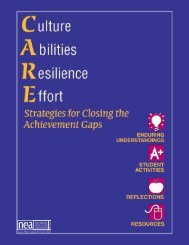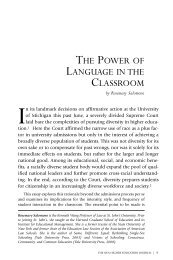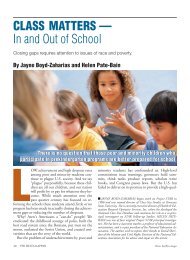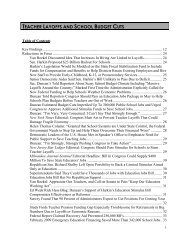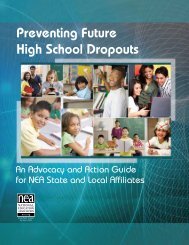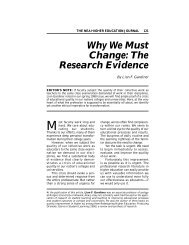Race Against Time: Educating Black Boys - National Education ...
Race Against Time: Educating Black Boys - National Education ...
Race Against Time: Educating Black Boys - National Education ...
You also want an ePaper? Increase the reach of your titles
YUMPU automatically turns print PDFs into web optimized ePapers that Google loves.
<strong>Black</strong>s<br />
<strong>Race</strong> against time: educating <strong>Black</strong> <strong>Boys</strong><br />
<strong>Black</strong> boys like Robert, John, and Devin don’t have much<br />
patience for statistics on <strong>Black</strong> boys. Homeless for the third<br />
time this year, Robert is set to graduate from Washington,<br />
D.C’s Cardoza High School with a 3.86 grade point average,<br />
fostering daydreams about his own college dorm room<br />
where no one can kick him out. His classmate and best<br />
friend John, a fine student and star athlete, has spent most<br />
of his young life in a group home; yet, when asked about<br />
his post-college plans, John’s answer isn’t pro football<br />
but physical education teacher. Then there’s Devin, who<br />
having dropped out of Cardoza, is excelling in boot camp<br />
and has just passed the GED, step one in becoming a<br />
military police officer. The trouble with statistics, say all<br />
three boys, is that the numbers color them invisible.<br />
...the surprising news, at once puzzling<br />
and promising, is that we actually have<br />
tools to reverse this trajectory and success<br />
stories to prove it...<br />
As the nation enters its third year under the leadership of<br />
its first <strong>Black</strong> president, a man so well educated his critics<br />
have labeled him an elitist, the numbers tell us many<br />
<strong>Black</strong> male students are more likely to hit the streets than<br />
the books. In just 2010 alone, the release of three highprofile<br />
research studies generated national debate on the<br />
academic prospects of <strong>Black</strong> boys. The statistics describing<br />
<strong>Black</strong> boys as more likely than peers to be placed in special<br />
education classes, labeled mentally retarded, suspended<br />
from school, or drop out altogether is disturbing enough.<br />
But the surprising news, at once puzzling and promising,<br />
is that we actually have tools to reverse this trajectory and<br />
success stories to prove it—not just individual victories,<br />
like Robert, John, and Devin, but victory in numbers.<br />
F e B R u a R y 2 0 1 1<br />
1<br />
What the Numbers say<br />
Several recent studies, including Yes We Can, the Schott<br />
Foundation’s 50-State Report on Public <strong>Education</strong> and <strong>Black</strong><br />
Males; A Call for Change, by the Council of the Great City<br />
Schools; and We Dream a World, by the 2025 Campaign for<br />
<strong>Black</strong> Men and <strong>Boys</strong>, report that <strong>Black</strong> youth are struggling<br />
along all points of the academic continuum.<br />
� Forty-two percent of <strong>Black</strong> students attend schools<br />
that are under-resourced and performing poorly.<br />
� <strong>Black</strong> boys are three times more likely to be<br />
suspended or expelled from school than their<br />
White peers, missing valuable learning time in the<br />
classroom.<br />
� <strong>Black</strong> and Hispanic males constitute almost 80<br />
percent of youth in special education programs.<br />
� <strong>Black</strong> boys are 2.5 times less likely to be enrolled<br />
in gifted and talented programs, even if their prior<br />
achievement reflects the ability to succeed.<br />
� <strong>Black</strong> male students make up 20 percent of all<br />
students in the United States classified as mentally<br />
retarded, although they are only nine percent of<br />
the student population.<br />
� Twenty-eight percent of core academic teachers at<br />
high-minority schools lack appropriate certification.<br />
� Less than half of <strong>Black</strong> male students graduate from<br />
high school on time, although many eventually<br />
complete a GED.<br />
� In 2008, 4.6 million <strong>Black</strong> males had attended<br />
college, but only half graduated. <strong>National</strong>ly, only<br />
11 percent of <strong>Black</strong> males complete a bachelor’s<br />
degree.
Focus On 2011<br />
<strong>Black</strong>s<br />
The same studies that describe <strong>Black</strong> male students in<br />
crisis also identify bright lights—individuals, schools, and<br />
districts—doing extraordinary work: A New Jersey school<br />
that graduates 100 percent of its <strong>Black</strong> male students. School<br />
districts like Montgomery County, Maryland, where <strong>Black</strong><br />
male student graduation rates are significantly higher than<br />
the national average. An NEA Priority school in Ohio that<br />
has dramatically transformed school climate in just one year.<br />
U.S. Department of Defense schools around the globe that<br />
have narrowed or virtually eliminated achievement gaps.<br />
Some educators say these successes prove transformative<br />
work can be done if the nation focuses as keenly on solutions<br />
as it has on symptoms.<br />
making it cool to soaR<br />
The Schott Foundation report cites New Jersey as the only<br />
state with a significant <strong>Black</strong> male population with a greater<br />
than 65 percent graduation rate, due in part to increased<br />
funding from Abbott v. Burke legislation benefiting urban<br />
schoolchildren. New Jersey’s 32 “Abbott” districts provide<br />
0-4 preschool preparation, increased education hours for<br />
students, continuous professional development for school<br />
staff, improved facilities, and supplemental programs for<br />
students in poverty.<br />
The performance of students at New Jersey’s Newark Tech<br />
High School, recognized by U.S. News & World Report magazine<br />
as one of the best high schools in the United States, is<br />
particularly impressive. Of the 700 mostly <strong>Black</strong> and Hispanic<br />
students attending Newark Tech, more than 85 percent<br />
qualify for free and reduced lunch. Last year, 88 percent of the<br />
student body tested proficient in math, 100 percent tested<br />
proficient in reading, and 100 percent graduated, begging the<br />
question: what is Newark Tech doing that many other schools<br />
aren’t? In fact, Newark Tech principle Baruti Kafele believes<br />
that the picture the Schott report paints about New Jersey’s<br />
success rate with <strong>Black</strong> boys is a bit too rosy.<br />
“Most school systems are addressing this crisis as an<br />
academic problem, but these kids are in self-crisis,”<br />
explains Kafele. "We can’t address a crisis of self-image,<br />
self-esteem, self-discipline, and self-respect as an<br />
academic problem, and if we keep trying to solve it in<br />
terms of math and reading models, we’ll be coming to the<br />
same conferences and reading the same reports 25 years<br />
from now,” he warns. Kafele, whose African first name<br />
means “teacher,” believes that schools have to address the<br />
“affective” before they address the academic. “The generic<br />
approach isn’t working,” he argues.<br />
2<br />
When Kafele first arrived at Newark Tech, the school was on<br />
the district’s school improvement list. Kafele and his staff set<br />
about transforming school climate and culture, using a suite<br />
of student-centered strategies to turn the school around:<br />
school leadership. No matter how highly motivated and<br />
highly trained the staff, they need the full support of a<br />
leader who takes ownership of the work, says Kafele, who<br />
personally greets each student at the school door every<br />
morning, Kafele also blasts a positive daily message on<br />
the public address system to counter all the negative<br />
messages students get outside of school.<br />
male empowerment sessions. Weekly sessions on<br />
manhood and classroom dynamics include one-onone<br />
conversations, large and small group work, and<br />
frank discussions with men from the community. Senior<br />
students visit area elementary schools to model manhood<br />
for young boys. “A few years ago, it wasn’t popular for boys<br />
at our school to be smart, confides Kafele. “We've made it<br />
cool for gangbangers to soar.”<br />
culturally responsive school. Newark Tech staff utilizes<br />
culturally responsive curriculum and instruction that<br />
recognizes students’ cultural backgrounds, home<br />
environments, and the impact of student experiences on<br />
the teaching and learning process. Instead of worrying<br />
about the achievement gap, says Kafele, educators<br />
focus on the learning gap (the reasons individual<br />
students aren’t learning rather than the metrics), the<br />
attitude gap (the gap between students who believe in<br />
themselves and those who don’t), the relationship gap<br />
(students who have a solid relationship with educators<br />
versus those who don’t), the opportunity gap (students<br />
who have access to a great public school versus<br />
those who don't), and the relevance gap (lessons that<br />
students can apply to their daily lives versus lessons<br />
that are abstract and intangible.)<br />
Committed educators and the funding that poured into<br />
New Jersey’s poorest districts helped New Jersey narrow<br />
its achievement gap, says Jacqui Watts Greadington,<br />
President of the East Orange <strong>Education</strong> Association and<br />
Chair of NEA’s <strong>Black</strong> Caucus. She’s worried these gains<br />
will slip away, however, in the face of funding cuts and<br />
the absence of a dialogue between the current governor<br />
and the union. “What makes students successful,” says<br />
Greadington, “is the communication between adults—<br />
school, home, community, and legislators—who have<br />
students' best interests at heart.”
Beating the odds<br />
The importance of school-home connectedness and<br />
culturally responsive instruction can’t be overestimated,<br />
says Mavis Ellis, chair of the Maryland State Teacher's<br />
Association Human and Civil Rights Committee and<br />
pupil personnel worker for Montgomery County, one of<br />
two Maryland school districts commended in the Schott<br />
Report. Montgomery County's 2010 graduation rate for<br />
<strong>Black</strong> males is 83 percent, 36 percent above the national<br />
average for <strong>Black</strong> males cited in the Schott Report. Last<br />
year, the district’s <strong>Black</strong> students (23 percent of the<br />
total student population) made Adequate Yearly Progress<br />
across all grade levels, with the exception of middle school<br />
math scores.<br />
As a pupil personnel worker who advocates for students<br />
and their families, Ellis works closely with students who<br />
have academic, attendance, and discipline issues. Sitting on<br />
special education teams, case managing students who’ve<br />
been expelled, and working with families in need had<br />
familiarized her with inequities faced by <strong>Black</strong> males.<br />
Only 19 percent of Maryland’s total student population<br />
in 2005, <strong>Black</strong> males comprised 62 percent of all male<br />
students identified as mentally retarded, 57 percent of<br />
males identified as emotionally disturbed, and 44 percent<br />
of those identified as developmentally delayed. In fact,<br />
notes Dr. Oscar Barbarin, a research psychologist known<br />
for his work with <strong>Black</strong> and Hispanic children, <strong>Black</strong><br />
boys are stigmatized as being “bad” children as early as<br />
preschool.<br />
Fortunately, says Ellis, in recent years there has been a<br />
change in Maryland's tracking of <strong>Black</strong> male students.<br />
To compensate for institutionalized inequity in the<br />
treatment of <strong>Black</strong> boys, the Maryland State Department<br />
of <strong>Education</strong> (MSDE) began closely monitoring the<br />
process when minority students were placed in special<br />
education, labeled emotionally disturbed, or singled out<br />
for suspension or expulsion. As a result, the overall number<br />
of <strong>Black</strong> boys coded for special education has decreased in<br />
the last two years. The number of students suspended with<br />
recommendations for expulsion has also been significantly<br />
reduced. Ellis largely credits MSDE’s Positive Behavioral<br />
Interventions and Supports process, which emphasizes<br />
constructive interventions as an alternative to punitive<br />
disciplinary actions.<br />
3<br />
teN thiNgs you CaN Do to<br />
Promote Culturally resPoNsive<br />
iNstruCtioN<br />
1. Validate students’ cultural identity in classroom<br />
practices and instructional materials by using textbooks,<br />
designing bulletin boards, and implementing classroom<br />
activities that are culturally supportive. This may mean<br />
using supplementary resources that don’t perpetuate<br />
stereotypes or inadequately represent certain groups.<br />
2. acknowledge students’ differences as well as their<br />
commonalities and respond to their individual strengths<br />
and weaknesses.<br />
3. educate students about the diversity of the world<br />
around them so all students learn to relate positively to<br />
each other regardless of cultural and linguistic differences.<br />
4. Promote equity and mutual respect among students<br />
in ways that a) ensure fair treatment across all groups<br />
and b) carefully monitor behaviors that are traditionally<br />
rewarded to ensure they’re not culture bound.<br />
5. access students’ ability and achievement validly using<br />
appropriate and varied instruments and procedures that<br />
accurately reflect what students do know (not just what<br />
they don’t know, e.g., mainstream language and culture).<br />
6. Foster a positive interrelationship among students,<br />
their families, the community and school based on<br />
respect for the knowledge students bring with them to<br />
school. Tapping into community resources, participating<br />
in community events, and valuing the contributions of<br />
families and community strengthen this bond.<br />
7. motivate students to become active participants<br />
in their learning through reflection, goal-setting, selfevaluation,<br />
questioning, using feedback, and tailoring<br />
their learning strategies.<br />
8. encourage students to think critically by teaching<br />
them strategies for analyzing and synthesizing information<br />
and for viewing situations from multiple perspectives.<br />
9. challenge students to strive for excellence as<br />
defined by their potential to learn, regardless of their past<br />
history of failure.<br />
10. assist students in becoming socially and politically<br />
conscious so they can be contributing, responsible<br />
participants in school and society.<br />
Adapted from the <strong>National</strong> Center for Culturally Responsive <strong>Education</strong>al Systems
Focus On 2011<br />
<strong>Black</strong>s<br />
In addition to positive interventions, Montgomery County<br />
Public Schools (MCPS) has used an array of institutional<br />
strategies to improve the performance of <strong>Black</strong> male<br />
students:<br />
expansion of full-day pre-kindergarten. Investments in<br />
pre-kindergarten and direct linking of pre-K programs to<br />
high standards in the K-12 curriculum are paying huge<br />
dividends for students, especially poor children. A Pew<br />
Center report details how expanded access to full-day<br />
pre-kindergarten has helped narrow the achievement gap<br />
before MCPS students start kindergarten.<br />
differentiation of resources. Schools with high<br />
concentrations of historically underserved students (low<br />
income, high minority, and English language learners)<br />
receive more funding per pupil than those schools with<br />
low or no concentrations of such students. Differentiation<br />
also takes the form of longer school days at some of the<br />
more disadvantaged schools.<br />
growing participation and success in advanced<br />
Placement (aP) course taking/exams. Between 2000 and<br />
2010, the number of MCPS students who take AP exams<br />
has more than tripled, while the number of tests taken that<br />
earned a college-ready score of three or higher also tripled.<br />
By using a variety of tools to identify promising students<br />
who might not otherwise enroll in AP courses, MCPS has<br />
pursued a deliberate strategy to increase the number of<br />
poor and minority students in AP courses.<br />
“It’s not about hiring Hercules but about<br />
creating a welcome environment where<br />
adults can be skillful and students can<br />
get the support they need.”<br />
“It’s not about hiring Hercules but about creating a<br />
welcome environment where adults can be skillful and<br />
students can get the support they need,” says Robert<br />
Balfanz, co-director of the Everybody Graduates Center<br />
at Johns Hopkins University, and associate director of<br />
the Talent Development Middle and High School Project,<br />
which is currently working with more than 50 high-poverty<br />
secondary schools around the country to translate research<br />
findings into concrete reforms. Balfanz credits multiple<br />
4<br />
strategies with driving improvements in a number of<br />
school districts: reducing chronic absenteeism and out-ofschool-suspensions,<br />
organizing teacher teams, increasing<br />
instructional supports and professional development,<br />
providing wraparound social services, and enlisting<br />
community partners to increase the ratio of concerned<br />
adults to students in need. Baltimore, Maryland, the latest<br />
district to see notable improvement, has a “Great Kids<br />
Come Back Campaign” that sends volunteers out to knock<br />
on doors and coax dropouts back to school.<br />
Ninety-two percent of Belmont seniors<br />
are on track to graduate, and this past<br />
year, as many boys as girls made the<br />
honor roll.<br />
Promising reforms are taking place in individual districts<br />
across the state and the nation, but they often happen in<br />
silos, says Michial Gill, Deputy Director for Governmental<br />
Relations and Minority Student Achievement Specialist<br />
for the Maryland State Department of <strong>Education</strong>. To<br />
make improvements statewide, MSDE formed the African-<br />
American Males Initiative, a workgroup charged with<br />
implementing the recommendations of an education<br />
task force. In addition to recommending a three-credit,<br />
MSDE-approved cultural proficiency course for educators,<br />
the African-American Males Initiative is launching an<br />
awareness campaign to promote widespread sharing of<br />
successful solutions.<br />
a FResh staRt<br />
An NEA Priority School, Belmont High is located in Ohio,<br />
one of the nation’s ten lowest performing states for <strong>Black</strong><br />
males, according to the 2010 Schott Report. NEA’s Priority<br />
Schools Campaign, which uses NEA members to raise<br />
student achievement in the nation’s struggling schools, is<br />
supporting transformative change at Belmont. Currently<br />
on “Academic Watch,” Belmont has begun implementing<br />
the NEA-recommended “transformation model” of schoolreform<br />
for the 2010-2011 school year. Considered a “war<br />
zone” just three years ago, the ethnically diverse highpoverty<br />
school serves approximately 1,000 students,<br />
Continued on page 7
straight talk With blaCk stuDeNts<br />
College students Elijah and Rachel Jones, Guy Foster, and Nemya Robinson are friends who attended high<br />
school together in Montgomery County, Maryland. Fraternal twins, Elijah and Rachel went to the same<br />
schools and shared many of the same classes. The four friends talk frankly about their personal experiences<br />
as <strong>Black</strong> students.<br />
Q: Were you and your brother,<br />
elijah, treated the same or<br />
differently at school?<br />
Rachel: My brother and I<br />
definitely got different treatment<br />
in elementary school.<br />
elijah: There were times when my<br />
friend C.J. and I would talk out of<br />
turn and<br />
they tried<br />
to put both<br />
of us on<br />
Ritalin and<br />
certify us<br />
as stupid.<br />
Meanwhile,<br />
my White<br />
friend<br />
<strong>Black</strong> boys are<br />
punished more severely<br />
for the same infractions<br />
as<br />
their White peers.<br />
—Schott Report<br />
threw temper tantrums where<br />
he flipped over tables and flung<br />
scissors. The principal would be<br />
called in, and the world would<br />
stop while everyone talked to him<br />
gently. Had I done that, they would<br />
have just put me in handcuffs.<br />
Rachel: From my viewpoint,<br />
watching this happen, all the kids<br />
acted like kids, but Elijah and C.J.<br />
were picked on if they so much as<br />
dropped their pencils.<br />
elijah: I felt like they were trying<br />
to prove a point with me. Let’s just<br />
catch him. I constantly got pulled<br />
aside and tested. I tested two<br />
grades higher than my grade level,<br />
and they couldn’t explain it. They<br />
were kind of shocked. What does<br />
this mean? What do we do now?<br />
Rachel: I feel like when you’re young,<br />
that’s when they try to get you. Then<br />
when you’re older, you’ll fall into all<br />
the statistics we hear about.<br />
Q: how did you do in high school?<br />
Rachel: I was shocked by high<br />
school at first. In my middle<br />
school, it was all about respecting<br />
your teachers. My first day in<br />
high school, a girl cursed at the<br />
teacher and somebody threw<br />
a chair. The kids were out of<br />
control.<br />
elijah: Senior year was my<br />
favorite because I was involved<br />
in a lot of school activities and<br />
did my senior internship at an<br />
architecture firm. My senior grade<br />
point average was 3.8.<br />
Q: Which students did the best?<br />
guy: The White kids.<br />
elijah: The students who knew<br />
how to make school work for<br />
them, whether they were White,<br />
<strong>Black</strong>, or Asian.<br />
Rachel: Still, the majority of<br />
students who took AP classes and<br />
honors courses were White kids.<br />
nemia: I don’t feel like it’s about<br />
race. It’s about environment. A<br />
lot of <strong>Black</strong> kids who went to my<br />
school were super smart. They<br />
were doing what they needed to<br />
do to get the grades. I would say<br />
50 percent of <strong>Black</strong> kids were into<br />
5<br />
scholarships and good grades,<br />
whereas 80 percent of the White<br />
kids had an education mindset.<br />
Q: What can we do to make <strong>Black</strong><br />
students, especially males, more<br />
successful?<br />
Rachel: I think it starts at home.<br />
As cliché as it sounds, we do need<br />
more <strong>Black</strong> male role models. If<br />
you’re brought up to know better,<br />
then you do better, and you give<br />
back to the community. As for the<br />
school system, it’s time for them to<br />
change what they teach everybody.<br />
nemia: People need good<br />
influences and role models,<br />
whether it’s at school or at home.<br />
It’s a collective effort. If you’re<br />
teaching in a school, you need to<br />
be positive. If you’re a [hip-hop<br />
artist], we need more Lupe Fiasos<br />
and less Lil Wayne.<br />
elijah: Did the majority of the<br />
<strong>Black</strong> kids I went to school with<br />
have a lot of self-esteem and<br />
self-love? Some thought they did,<br />
but they didn’t. I thought I was<br />
doing well when I got an A on a<br />
test, but some guys thought they<br />
were doing well when they got 15<br />
friend requests on Facebook.<br />
elijah: Someone needs to start a<br />
movement, and it needs to be us.<br />
guy: Yeah, we need a rebirth—a<br />
new Harlem Renaissance.
Focus On 2011<br />
<strong>Black</strong>s<br />
What CaN elemeNtary eDuCators Do?<br />
The NEA seminar, “Promoting Success of African-<br />
American <strong>Boys</strong> by Understanding and Reducing Stigmas<br />
and Stereotypes,” highlighted eight overarching<br />
strategies elementary educators can use in their work.*<br />
1. uncover and rid ourselves of attitudes,<br />
misconceptions, stereotypes, and inappropriate<br />
methods that undermine effective, nurturing<br />
teaching.<br />
� When boys fail to respond in the desired way to<br />
methods educators are familiar with, some teachers<br />
respond by distancing themselves emotionally or<br />
developing negative ideas about a child’s motivation<br />
and abilities. Let go of assumptions, such as boys<br />
who don’t sit still or focus aren’t interested in<br />
learning, and unfamiliar or culturally comfortable<br />
behaviors reflect a learning or behavioral disability.<br />
� Avoid punishment that denies a child the teaching<br />
methods he most needs to be successful, for<br />
instance, isolation rather than cooperative learning<br />
and extra sitting rather than large-motor, physical<br />
activity.<br />
2. Build a strong, knowledgeable, empathetic caring<br />
relationship with students.<br />
� Believe and make visible your belief in a child’s potential<br />
to succeed. Know every child as he is—not the mainstream<br />
cultural image of how a child should be.<br />
3. Build strong, caring relationships with families.<br />
� Learn about the family’s dreams, hopes, and<br />
expectations for their son and their expectations re<br />
adult-child relationships, management techniques,<br />
and cues. Ask what their son is like at home and<br />
about his relationship with his peers. Let families<br />
know their son’s (and daughter’s) successes on a<br />
regular basis.<br />
4. understand and plan for cultural and language<br />
discontinuity.<br />
� See being bicultural as a strength, rather than a<br />
difficulty. Know management cues children learn<br />
at home, and help them make a bridge to the cues<br />
you use.<br />
6<br />
5. Recognize learning styles as strengths, adapt your<br />
methods, and re-teach concepts in ways a child<br />
can best learn.<br />
� Work together in learning activities and maintenance<br />
tasks that promote community spirit.<br />
� Use a 2-1 balance of teacher-initiated activities requiring<br />
interactive/free talk and focusing skills/quiet time that<br />
prepares students for independent learning behaviors<br />
typically required in primary schools.<br />
6. Recognize and use boys’ physical energy and<br />
kinesthetic learning as an attribute.<br />
� Provide several opportunities during the day for physical<br />
activity, follow high-energy activities with sitting activities,<br />
and create literacy activities suited to kinesthetic learners.<br />
7. understand and actively counter the impact of<br />
racism on a child’s sense of competency and<br />
identity.<br />
� Include community role models for <strong>Black</strong> boys in<br />
ongoing activities with children. Develop materials and<br />
activities to counter media-fostered negative images and<br />
messages about <strong>Black</strong> men. Regularly teach about the<br />
contributions men of color have made to our society, a<br />
lesson that benefits all children.<br />
8. Practice anti-bias strategies.<br />
� Build community among the children—caring for each<br />
other and working together.<br />
� Foster children’s learning about, appreciating, and<br />
respecting their differences, commonalities, and<br />
contributions to the whole group.<br />
� Foster critical thinking skills (e.g. use multicultural books<br />
that model or explore social justice).<br />
� Immediately intervene in any hurtful behaviors related<br />
to identity (sticks and stones can break my bones, but<br />
words can break my heart). Help children learn ways<br />
to speak up when they experience or witness hurtful<br />
behavior.<br />
� Be an advocate, speaking directly to any injustice you see<br />
in the learning environment.<br />
*Adapted from research by Oscar Barbarin, Ph.D., and materials<br />
prepared by Jawanza Kunjufa and Louise Derman-Sparks.
Continued from page 4<br />
40 percent of whom are <strong>Black</strong>. In just one year’s time,<br />
school fights have decreased from 143 to 17, assaults from<br />
83 to 10, and arrests from 53 to 1. Ninety-two percent of<br />
Belmont seniors are on track to graduate, and this past<br />
year, as many boys as girls made the honor roll, says<br />
Principal David White.<br />
Although Belmont faces many challenges, particularly in<br />
the areas of student motivation and parent engagement,<br />
the principle and school staff credit initial gains to several<br />
factors:<br />
staff collaboration. Close collaboration is a foundation of<br />
the school’s reform effort. During the summer, the entire<br />
staff met to plan a curricular scope and sequence for each<br />
day of school. Special education teachers wrote a modified<br />
version of the general education curriculum, ensuring that<br />
all students are moving through curricular targets at their<br />
own level.<br />
Positive use of data. The school’s new principal uses data<br />
feedback as a tool rather than a weapon report school<br />
staff, who say this is the first time they feel empowered by<br />
a reform effort. By looking at the data, school staff realized<br />
many students were missing school because they couldn’t<br />
afford bus fare, says Principal David White. “Poor families<br />
were choosing between buying Thanksgiving dinner and<br />
bus passes.”<br />
community outreach and parent engagement. Although<br />
Belmont’s parent and community relationships need<br />
strengthening (staff will focus on this topic in the coming<br />
year), they’re improving gradually as the school maintains<br />
a safer campus. The school recently became a partner with<br />
the Belmont Community Association and contributes to<br />
the community newsletter.<br />
“Everything falls into place when you treat each child as if<br />
they were your own,” says Jeffrey Mims, Ohio state school<br />
board member and former Dayton <strong>Education</strong> Association<br />
president. Mims, who managed district programs for at-risk<br />
youth after teaching at Belmont for seven years, credits the<br />
school’s current principal and staff with developing critical<br />
personal relationships with each student. Treating every<br />
student with the dignity, respect, guidance, discipline, and<br />
caring passion you’d give your own child works well with<br />
<strong>Black</strong> males, asserts Mims, because many rarely receive this<br />
kind of treatment. “Our children start with a smaller basket<br />
7<br />
of resources but are expected to produce at the same level<br />
as kids in high-achieving, affluent communities,” Mims<br />
points out. “Schools and communities need more support<br />
to close the quality-of-life gap so closely linked to the<br />
achievement gap.”<br />
Wake-uP call<br />
In individual schools and districts across the country,<br />
educators are using a range of emerging strategies to narrow<br />
achievement gaps, boost graduation rates, and provide<br />
more equitable treatment for America’s <strong>Black</strong> male students.<br />
The resulting evidence is clear: schools with the greatest<br />
success invariably address a combination of interrelated<br />
factors in a child's life: academic, emotional, and social.<br />
Despite promising reforms, as yet, there is no coordinated<br />
national response for what amounts to a national crisis.<br />
The 2009 PISA (or Programme for International Student<br />
Assessment), which looks at 69 countries and school<br />
systems, ranked the United States average in reading and<br />
science and below average in mathematics, prompting<br />
<strong>Education</strong> Secretary Arne Duncan to declare the results a<br />
wake-up call.<br />
Schools with the greatest success address<br />
a combination of interrelated factors in<br />
a child's life: academic, emotional, and<br />
social.<br />
Changing the trajectory of <strong>Black</strong> male students may not<br />
yet be a national conversation, but it’s on the national<br />
radar screen. Just this year, the U.S. Department of<br />
<strong>Education</strong> convened "Increasing the Odds," its first panel<br />
on improving the academic prospects of America's <strong>Black</strong><br />
male students.<br />
The success of <strong>Black</strong> males has increasingly become a<br />
topic of research, dialogue, debate, and strategic planning.<br />
As we engage in the conversation, however, students like<br />
Cardoza’s Robert Butler, John Young, and Devin Harrington<br />
are reminders that we’re educating kids, not statistics, and<br />
that, as one <strong>Black</strong> student affirms, "The truth doesn't live<br />
in numbers. It lives in the person."
sources (listed in order of appearance)<br />
Yes We Can: The Schott 50 State Report on<br />
Public <strong>Education</strong> and <strong>Black</strong> Males. 2010. Schott<br />
Foundation for Public <strong>Education</strong>.<br />
A Call for Change: The Social and <strong>Education</strong>al<br />
Factors Contributing to the Outcomes of <strong>Black</strong><br />
Males in Urban Schools. October 2010. The<br />
Council of the Great City Schools.<br />
We Dream A World: The 2025 Vision for <strong>Black</strong> Men<br />
and <strong>Boys</strong>. December 2010. The Twenty-First<br />
Century Foundation.<br />
Rosales, J. "Rules of Engagement." NEA Today.<br />
January 2007.<br />
Barbarin, O .A. "Halting African American<br />
<strong>Boys</strong>’ Progression from Pre-K to Prison: What<br />
Families, Schools, and Communities Can<br />
Do! " American Journal of Orthopsychiatry. 2010.<br />
Vol. 80, No. 1. 81-88.<br />
Culturally Responsive Pedagogy and Practice,<br />
Academy 1: Understanding Cultural<br />
Responsiveness. 2008. <strong>National</strong> Center for<br />
Culturally Responsive <strong>Education</strong>al Systems.<br />
2010 Maryland Report Card. Maryland State<br />
Department of <strong>Education</strong>.<br />
Balfanz, R. Transforming Secondary Schools in an<br />
Era of College and Career Readiness for All. 2010.<br />
NEA Visiting Scholars Series Research Brief.<br />
Aarons, D. "City’s <strong>Black</strong> Males Stay in School."<br />
<strong>Education</strong> Week. December 16, 2009.<br />
Gewertz, C. " 'Diplomas' Now Offer Potential<br />
Dropouts Lots of Help." <strong>Education</strong> Week.<br />
December 16, 2009.<br />
African American Male Workgroup Report. 2009.<br />
Maryland State Department of <strong>Education</strong>.<br />
PISA 2009 Results. www.oecd.org/edu/pisa/



